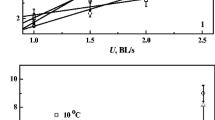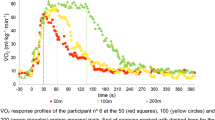Abstract
To investigate the effect of temperature on the repeat constant acceleration swimming performance and on the metabolic recovery capacity in juvenile qingbo (Spinibarbus sinensis), their constant acceleration test speed (U CAT) and excess post-exercise oxygen consumption (EPOC) recovery process were measured twice with 1-h intervals at different acclimation temperatures (10, 15, 20, 25 and 30 °C). Temperature significantly affected U CAT, the pre-exercise metabolic rate (MO2), metabolic peak values (MO2peak), the metabolic scope (MS, MO2peak—pre-exercise MO2) and the magnitude of the EPOC (P < 0.05). These parameters significantly increased as the temperature increased from 15 to 25 °C and significantly decreased (U CAT and EPOC magnitude) or did not change (MO2peak and MS) when the temperature increased from 25 to 30 °C in the first test (P < 0.05). The relationships between temperature (T) and these parameters (U CAT, MO2peak, MS and EPOC magnitude) in the first test were as follows: U CAT = 62.14/{1 + [(T − 25.1)/21.1]2} (r = 0.847, P < 0.001, n = 40); MO2peak = 1,052.11/{1 + [(T − 29.2)/18.9]2} (r = 0.901, P < 0.001, n = 39); MS = 753.74/{1 + [(T − 27.1)/18.6]2} (r = 0.768, P < 0.001, n = 39); and EPOC = 195.42/{1 + [(T − 25.6)/8.7]2} (r = 0.752, P < 0.001, n = 39). The optimal temperatures for U CAT, MO2peak, MS and EPOC magnitude in juvenile qingbo were 25.1, 29.2, 27.1 and 28.6 °C, respectively. Repeat exercise had different effect on U CAT and EPOC magnitude at different temperature (interaction effect, P < 0.05). There was no difference in U CAT and in EPOC magnitude between the first and second tests at low temperatures (10–20 °C). However, both U CAT and EPOC magnitude decreased significantly during the second test compared with the first test at high temperatures (25 and 30 °C) (P < 0.05). The present study showed that the recovery of the constant acceleration swimming performance was poorer at higher temperatures than at low temperatures in juvenile qingbo. These differences may be related to larger anaerobic metabolism, a lower pH value in the blood, larger ionic fluids and/or higher levels of hormones present at high temperatures.



Similar content being viewed by others
References
Beamish FWH (1978) Swimming capacity. In: Hoar WS, Randall JD (eds) Fish physiology, vol 7. Academic Press Inc, New York, pp 101–187
Børsheim E, Bahr R (2003) Effect of exercise intensity, duration and mode on post-exercise oxygen consumption. Sports Med 33:1037–1060
Brett JR (1964) The respiratory metabolism and swimming performance of young sockeye salmon. J Fish Res Board Can 21:1183–1226
Brett JR (1971) Energetic responses of salmon to temperature. A study of some thermal relation in the physiology and freshwater ecology of sockeye salmon (Oncorhynchus mykiss). Am Zool 11:99–113
Claireaux G, Couturier C, Groison AL (2006) Effect of temperature on maximum swimming speed and cost of transport in juvenile European sea bass (Dicentrarchus labrax). J Exp Biol 200:3420–3428
Duan XB, Chen DQ, Liu SP, Chi CG, Yang RH (2002) Studies on status of fishery resources in Three Gorges reservoir reaches of the Yangtze River. Acta Hydrobiol Sin 26:605–611
Farrell AP (2008) Comparisons of swimming performance in rainbow trout using constant acceleration and critical swimming speed tests. J Fish Biol 72:693–710
Farrell AP, Gamperl AK, Birtwell IK (1998) Prolonged swimming, recovery and repeat swimming performance of mature sockeye salmon Oncorhynchus nerka exposed to moderate hypoxia and pentachlorophenol. J Exp Biol 201:2183–2193
Fu SJ, Xie XJ, Cao ZD (2005) Effect of dietary composition on specific dynamic action in southern catfish Silurus meridionalis Chen. Aquac Res 36:1384–1390
Fu SJ, Zeng LQ, Li XM, Pang X, Cao ZD, Peng JP, Wang YX (2009) Effect of meal size on excess post-exercise oxygen consumption in fishes with different locomotive and digestive performance. J Comp Physiol B 179:509–517
Gaesser GA, Brooks GA (1984) Metabolic bases of excess post exercise oxygen consumption: a review. Med Sci Sports Exerc 16:29–43
Hammer C (1995) Fatigue and exercise tests with fish. Comp Biochem Physiol A 112:1–20
Hanna SK, Haukenes AH, Foy RJ, Buck CL (2008) Temperature effects on metabolic rate, swimming performance and condition of Pacific cod Gadus macrocephalus Tilesius. J Fish Biol 72:1068–1078
Jain KE, Farrell AP (2003) Influence of seasonal temperature on the repeat swimming performance of rainbow trout Oncorhynchus mykiss. J Exp Biol 206:3569–3579
Jain KE, Birtwell IK, Farrell AP (1998) Repeat swimming performance of mature sockeye salmon following a brief recovery period: a proposed measure of fish health and water quality. Can J Zool 76:1488–1496
Kieffer JD (2000) Limits to exhaustive exercise in fish. Comp Biochem Physiol A 126:161–179
Kieffer JD, Currie S, Tufts BL (1994) Effects of environmental temperature on the metabolic and acid-base responses of rainbow trout to exhaustive exercise. J Exp Biol 194:299–317
Kolok AS (1999) Interindividual variation in the prolonged locomotor performance of ectothermic vertebrates: a comparison of fish and herpetofaunal methodologies and a brief review of the recent fish literature. Can J Fish Aquat Sci 56:700–710
Lee CG, Farrell AP, Lotto A, Hinch GS, Healey MC (2003a) Excess post-exercise oxygen consumption in adult sockeye (Oncorhynchus nerka) and coho (O. kisutch) salmon following critical speed swimming. J Exp Biol 206:3253–3260
Lee CG, Farrell AP, Lotto A, MacNctt MJ, Hinch SG, Healey MC (2003b) The effect of temperature on swimming performance and oxygen consumption in adult sockeye (Oncorhynchus nerka) and coho (O. kisutch) salmon stocks. J Exp Biol 206:3239–3251
Luo YP, Wang W, Huang QD, Zhang YR, Lim D (2013) Effects of starvation on the excess post-exercise oxygen consumption of juvenile Nile tilapia (Oreochromis niloticus). Mar Freshw Behav Physiol 45:333–342
MacNutt MJ, Hinch SG, Farrell AP, Topp S (2004) The effect of temperature and acclimation period on repeat swimming performance in cutthroat trout. J Fish Biol 65:342–353
Marras S, Claireaux G, McKenzie DJ, Nelson JA (2010) Individual variation and repeatability in aerobic and anaerobic swimming performance of European sea bass, Dicentrarchus labrax. J Exp Biol 213:26–32
McKenzie DJ, Serrine G, Pariccini G, Bronzi P, Bolis CL (1996) Effects of diet on responses to exhaustive exercise in Nile Tilapia (Oreochromis nilotica) acclimated to three different temperatures. Comp Biochem Physiol A 114:43–50
Milligan CL (1996) Metabolic recovery from exhaustive exercise in rainbow trout. Comp Biochem Physiol A 113:51–60
Nelson JA, Tang Y, Boutilier RG (1996) The effects of salinity change on the exercise performance of two Atlantic cod (Gadus morhua) populations inhabiting different environments. J Exp Biol 199:1295–1309
Nelson JA, Gotwalt PS, Reidy SP, Webber DM (2002) Beyond U crit: matching swimming performance tests to the physiological ecology of the animal, including a new fish drag strip. Comp Biochem Physiol A 133:289–302
Oufiero CE, Garland T Jr (2009) Repeatability and correlation of swimming performances and size over varying time-scales in the guppy (Poecilia reticulata). Funct Ecol 23:969–978
Pang X, Cao ZD, Peng JL, Fu SJ (2010) The effects of feeding on the swimming performance and metabolic response of juvenile southern catfish, Silurus meridionalis, acclimated at different temperatures. Comp Biochem Physiol A 155:253–258
Pang X, Cao ZD, Fu SJ (2011) The effects of temperature on metabolic interaction between digestion and locomotion in juveniles of three cyprinid fish (Carassius auratus, Cyprinus carpio and Spinibarbus sinensis). Comp Biochem Physiol A 159:253–260
Pang X, Yuan XZ, Cao ZD, Fu SJ (2013) The effects of temperature and exercise training on swimming performance in juvenile qingbo (Spinibarbus sinensis). J Comp Physiol B 183:99–108
Pörtner HO, Farrell AP (2008) Physiology and climate change. Sci. 322:690–692
Randall D, Brauner C (1991) Effects of environmental factors on exercise in fish. J Exp Biol 160:113–126
Reidy SP, Nelson JA, Tang Y, Kerr SR (1995) Post-exercise metabolic rate in Atlantic cod and its dependence upon the method of exhaustion. J Fish Biol 47:377–386
Reidy SP, Kerr SR, Nelson JA (2000) Aerobic and anaerobic swimming performance of individual Atlantic cod. J Exp Biol 203:347–357
Richards JG, Mercado AJ, Clayton CA, Heigenhauser GJ, Wood CM (2002) Substrate utilization during graded aerobic exercise in rainbow trout. J Exp Biol 205:2067–2077
Steffensen JF (1989) Some errors in respirometry of aquatic breathers: how to avoid and correct for them. Fish Physiol Biochem 6:49–59
Tierney K (2000) The repeated swimming performance of sockeye, coho, and rainbow trout in varying environmental and physiological conditions. MSc thesis, Simon Fraser University Canada
Wagner GN, Balfry SK, Higgs DA, Lall SP, Farrell AP (2004) Dietary fatty acid composition affects the repeat swimming performance of Atlantic salmon in seawater. Comp Biochem Physiol A 137:567–576
Wood CM (1991) Acid-base and ion balance, metabolism, and their interactions after exhaustive exercise in fish. J Exp Biol 160:285–308
Yan GJ, He XK, Cao ZD, Fu SJ (2012) The trade-off between steady and unsteady swimming performance. J Therm Biol 37:424–431
Zeng LQ, Zhang YG, Cao ZD, Fu SJ (2010) Effect of temperature on excess post-exercise oxygen consumption in juvenile southern catfish (Silurus meridionalis Chen) following exhaustive exercise. Fish Physiol Biochem 36:1243–1252
Zhao WW, Pang X, Peng JL, Cao ZD, Fu SJ (2012) The effects of hypoxia acclimation, exercise training and fasting on swimming performance in juvenile qingbo (Spinibarbus sinensis). Fish Physiol Biochem 38:1367–1377
Zulkifli I, Liew PK, Israf DA, Omar AR, Hair-Bejo M (2003) Effects of early age feed restriction and heat conditioning on heterophil/lymphocyte ratios, heat shock protein 70 expression and body temperature of heat-stressed broiler chickens. J Therm Biol 28:217–222
Acknowledgments
This study was funded by the Natural Science Foundation of China (31172096).
Author information
Authors and Affiliations
Corresponding author
Rights and permissions
About this article
Cite this article
Pang, X., Yuan, XZ., Cao, ZD. et al. The effect of temperature on repeat swimming performance in juvenile qingbo (Spinibarbus sinensis). Fish Physiol Biochem 41, 19–29 (2015). https://doi.org/10.1007/s10695-014-0002-0
Received:
Accepted:
Published:
Issue Date:
DOI: https://doi.org/10.1007/s10695-014-0002-0




